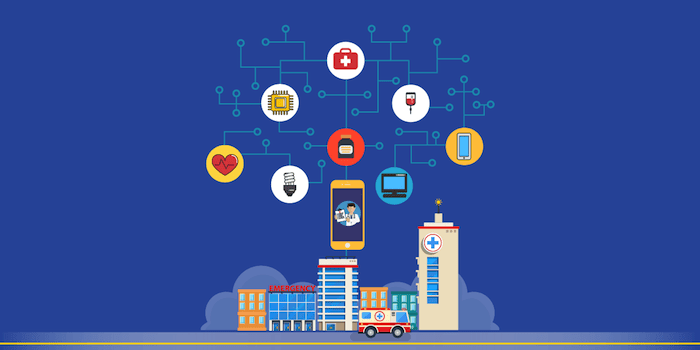By Oksana Mikhalchuk
Every day in the physical rehabilitation, especially of injured athletes, counts — and smart progress monitoring couldn’t be more useful. Wearable solutions already make mundane tests and condition evaluation easier and faster to perform, and IoT enhances the scale and quality of such checks.
Here’s how IoT in healthcare enables physiotherapists and other specialists to prevent future injuries and make the rehabilitation process more comfortable and informed.
Recovery progress monitoring
Wearables like smartwatches are the most popular accessories on the market. Thanks to them, IoT solutions can perform multi-channel, clinical-grade monitoring on an injured patient. Wearables are the easiest way to collect and transmit data to smartphones or other devices around, and the most accessible way to enhance and support daily recovery procedures.
Besides fitness-related accessories, there are many kinds of advanced smart equipment available. They include items of clothing with body-worn sensors to measure and collect simultaneous data about specific parameters — like activity type, intensity, pulse, blood pressure, blood sugar levels, respiratory patterns, etc.
Smart equipment and environment allow measuring the injury’s criticality and track recovery progress. Anything that is considered crucial like applied muscle force, respiration, blood biochemistry, can be tracked without on-site professional supervision. Such monitoring can be performed anytime even from home — not only in a medical facility or with a doctor present.
Personal rehabilitation plans
The same rehabilitation program can’t apply to 100% of patients with the same trauma type. To distinguish personal injury-related peculiarities and personalize the rehabilitation journey, AI-driven IoMT systems create a patient-specific personal movement profile — and use it to define individual milestones for improvement.
After the movement profile is completed, an AI- and ML-driven system can compare it with the data collected by wearables. Because of continuous monitoring, the system registers non-obvious patterns in the patient’s dynamic. After analyzing these insights, it suggests an optimal rehabilitation plan for medical specialists to consider.
Even though a medical professional’s opinion is still required, there are a few game-changing benefits of AI-powered rehabilitation plans: they save time on examining medical history, can help avoid treatment mistakes and imply additional treatment options.
Injuries prediction and prevention
The data output from smart equipment is too massive and diverse to decode, let alone to review and analyze for a single person. Thanks to IoT-supported analytics tools, both doctors and patients receive a clear-looking summary of the current condition at any point in time.
Adapting AI can go further and use medical history, movement profile, and manually added remarks to prevent a repeated injury. The system doesn’t only discover trends and detects anomalies — most importantly, it can indicate the critical points where the next trauma might occur.
For example, an athlete with any musculoskeletal injury has a higher risk of aggravating the damage through intense workouts. Smart wear can notice the pulse being too high, extra muscle tension around the injured knee or elbow, or discomfort signals from the patient — and notify about the exercise being too dangerous.
Remote consultations and monitoring
Computers have done remote consultations available and accessible for patients long ago. They make the recovery period more comfortable, especially for people with limited mobility who are not able to visit therapy sessions often.
When IoT joins the recovery process, it allows for cooperation between multiple medical specialists and keeps everyone on the same page. The information on the patient’s condition and procedures is always available online for all parties involved — to accelerate decisions on recovery steps.
Adopting wearables also benefits the remote monitoring and consultation quality. Wearables and other devices collect real-time feedback from the patient, and deliver it to the doctors automatically for recovery plan adjustments, without a personal appointment needed.
IoT in healthcare enhances informed recovery decisions
The main takeaway of IoT in rehabilitation is that everything can be monitored, analyzed and personalized with little to no disruption of the patient’s comfort and rehabilitation routine.
Even though physical rehabilitation is not possible without surveillance yet, IoT enriches it with multifaceted and remote round-the-clock monitoring. Wearables, smart clothing and utilities like smart exercise machines enable fine-tuned recovery — plus, they gather factual statistiсs in minutes. With such data on their hands, therapists are better informed for strategic moves while being better positioned to prevent secondary traumas.
Oksana Mikhalchuk is a Technology Writer at Oxagile, a software engineering company with focus on healthcare solutions.
Throughout the year, our writers feature fresh, in-depth, and relevant information for our audience of 40,000+ healthcare leaders and professionals. As a healthcare business publication, we cover and cherish our relationship with the entire health care industry including administrators, nurses, physicians, physical therapists, pharmacists, and more. We cover a broad spectrum from hospitals to medical offices to outpatient services to eye surgery centers to university settings. We focus on rehabilitation, nursing homes, home care, hospice as well as men’s health, women’s heath, and pediatrics.








